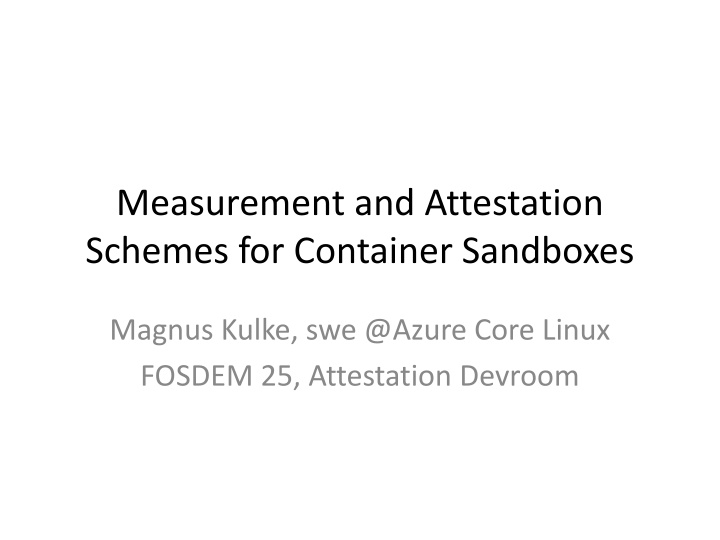
Measurement and Attestation Schemes for Container Sandboxes in Confidential Computing
"Explore measurement and attestation schemes for container sandboxes in the context of confidential computing, including the role of Kubernetes, OCI images, and the use of VM technology like Kata Containers. Learn about the components and architecture involved in ensuring secure container environments for executing operations effectively."
Download Presentation

Please find below an Image/Link to download the presentation.
The content on the website is provided AS IS for your information and personal use only. It may not be sold, licensed, or shared on other websites without obtaining consent from the author. If you encounter any issues during the download, it is possible that the publisher has removed the file from their server.
You are allowed to download the files provided on this website for personal or commercial use, subject to the condition that they are used lawfully. All files are the property of their respective owners.
The content on the website is provided AS IS for your information and personal use only. It may not be sold, licensed, or shared on other websites without obtaining consent from the author.
E N D
Presentation Transcript
Measurement and Attestation Schemes for Container Sandboxes Magnus Kulke, swe @Azure Core Linux FOSDEM 25, Attestation Devroom
Context Confidential Containers (CoCo) CNCF project vendor neutral Facilitate confidential computing in the container ecosystem Confidential Computing is (mostly) a VM technology Containers usually do not run in VMs Kata Containers adds virtualization as isolation layer
What is a typical container launch? K8s node K8s RPC K8s API Server Kubelet CRI Calls Containerd K8s pod spec OCI Runtime Calls Sandbox process Runc process
Sandbox? Pod: Kubernetes deployment atom . Set of collocated processes (containers) that share namespaces and resources Good abstraction to introduce confidentiality boundaries
Confidential container launch K8s node K8s RPC K8s API Server Kubelet CRI Calls OCI Runtime Calls Containerd K8s pod spec Kata shim Confidential VM Kata RPC Sandbox process Kata Agent
or with a remote CVM K8s node K8s RPC K8s API Server Kubelet CRI Calls OCI Runtime Calls Containerd K8s pod spec Kata shim Confidential VM Kata RPC Sandbox process Kata Agent
Static and dynamic components ? Well covered: UKIs, dm-verity, systemd
Attesting a container environment Objective: Ensure that only intended operations are executed within the sandbox (before releasing a secret) Requires: A comprehensive measurement of the container workload
Challenges in dynamic environments Dynamic Nature of Pods: Pods can have containers created, deleted, or updated imperatively. Dynamisms make it challenging to guarantee integrity. Kubernetes Control Plane: Can and will adjust a user s pod spec Examples: env variables, admission controllers
Options Lock k8s control plane: Allow only trusted (predictable) operations K8s api surface is huge, increasing constantly Requires lots of glue code and ceremony Effort underway: split-api
Options Keep a log (Somewhat) like linux IMA Record Kata RPC + payloads into replayable log Not all TEEs provide registers that can be extended at runtime Some payloads are not predictable, b/c controlled by the env Verification is not trivial
Options Policy in the TEE Describe invariants (image digest) Allow acceptable dynamism (env: SERVICE_*) Reject Kata RPCs by default cherrypick what s required Currently implemented in Kata-Agent Engine based on Rego (popular in container-land) genpolicy tool to generate policy from a pod spec
Plugging policy eval into the workflow Kata shim Confidential VM Kata RPC Sandbox process Policy engine Kata Agent
How to provide a policy to the TEE? Policy is specific per workload CVM images are generic Provide it as measured configuration at launch Link it to the TEE HW evidence Put hash in HOSTDATA (SEV-SNP), MRCONFIGID (TDX), part of signed HW evidence (verify in TEE) Extend runtime registers (vTPM)
Init-Data Specification Measured configuration for CoCo TOML dict of path/file content Currently being implemented Available for some TEEs Embed into Pod spec as annotation
Challenges Policy is stateless, declarative Kata RPC is imperative What about more complex orchestration? launch container x first (init container) then container y Ongoing effort: stateful policies
Challenges Practical problems Size of policies? Policies can be quite large Pod annotation has limits Compression, splitting, bundling a library User experience is subpar Rego is modelled after Datalog Unusual paradigms Not trivial to write large policies
Challenges Conceptual problems, maybe? Have to track kata s RPC interface closely New exploit vectors can be introduced inadvertently Kata is not just for CoCo use case Need to keep tabs on API changes in semantics and implementation
Challenges Runtime measurements (very) long running workloads in TEEs Examples: LLM inference, training tasks Continuous measurement to catch drift Not all TEEs have PCRs/RTMRs Can be retrofitted via privilege levels + paravisor/SVSMs. Composite TEEs Confidential GPUs + Confidential CPUs Potentially more, e.g. accelerated NICs Attest individually? Chained?
Recap Attestation for container sandboxes is tricky due to inherent dynamic nature. Offloading verification to a policy is a viable mitigation Few challenges remain, most seem manageable But policy is maybe not fully adequate
References Confidential Containers Kata Containers - Open Source Container Runtime Policing a Sandbox | Microsoft Community Hub CoCo Initdata spec
